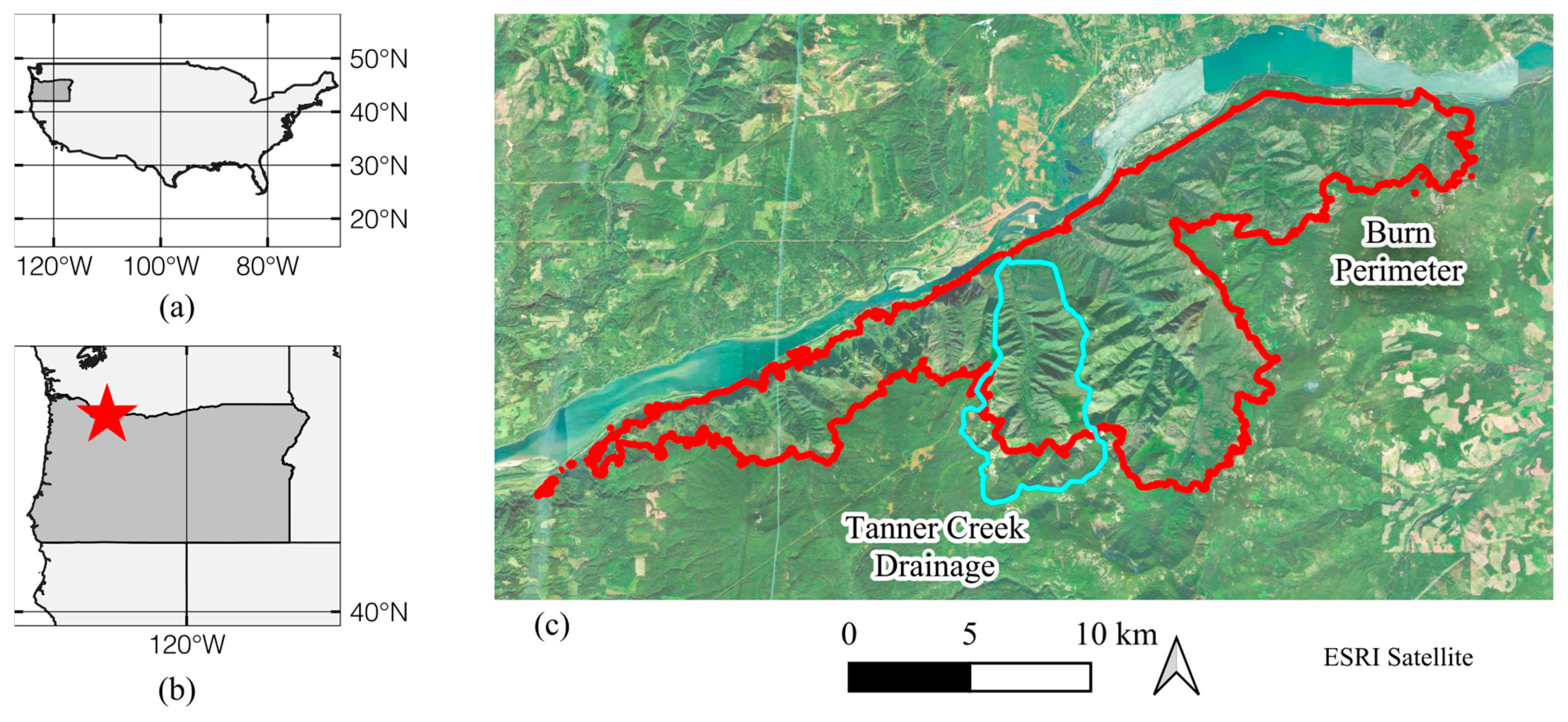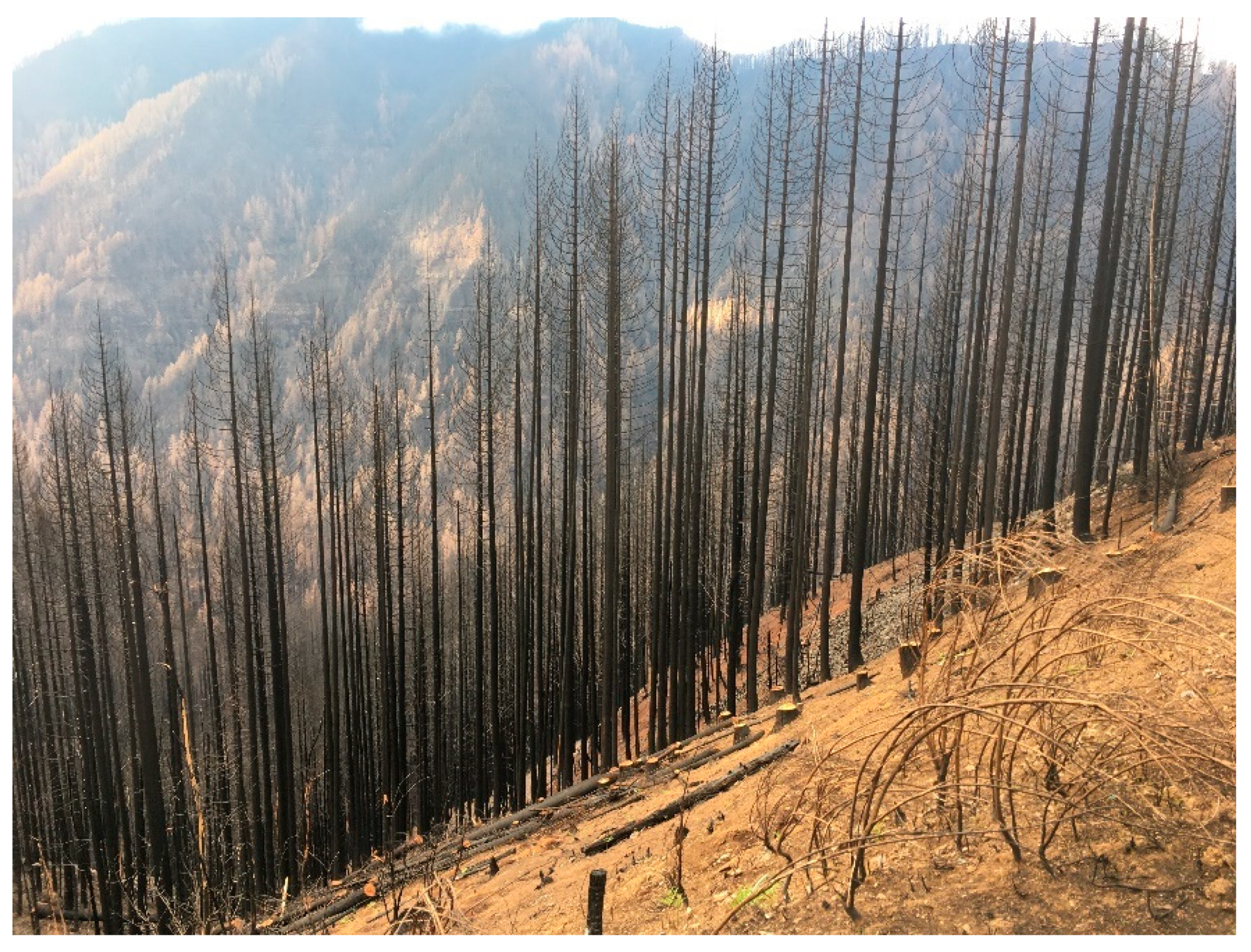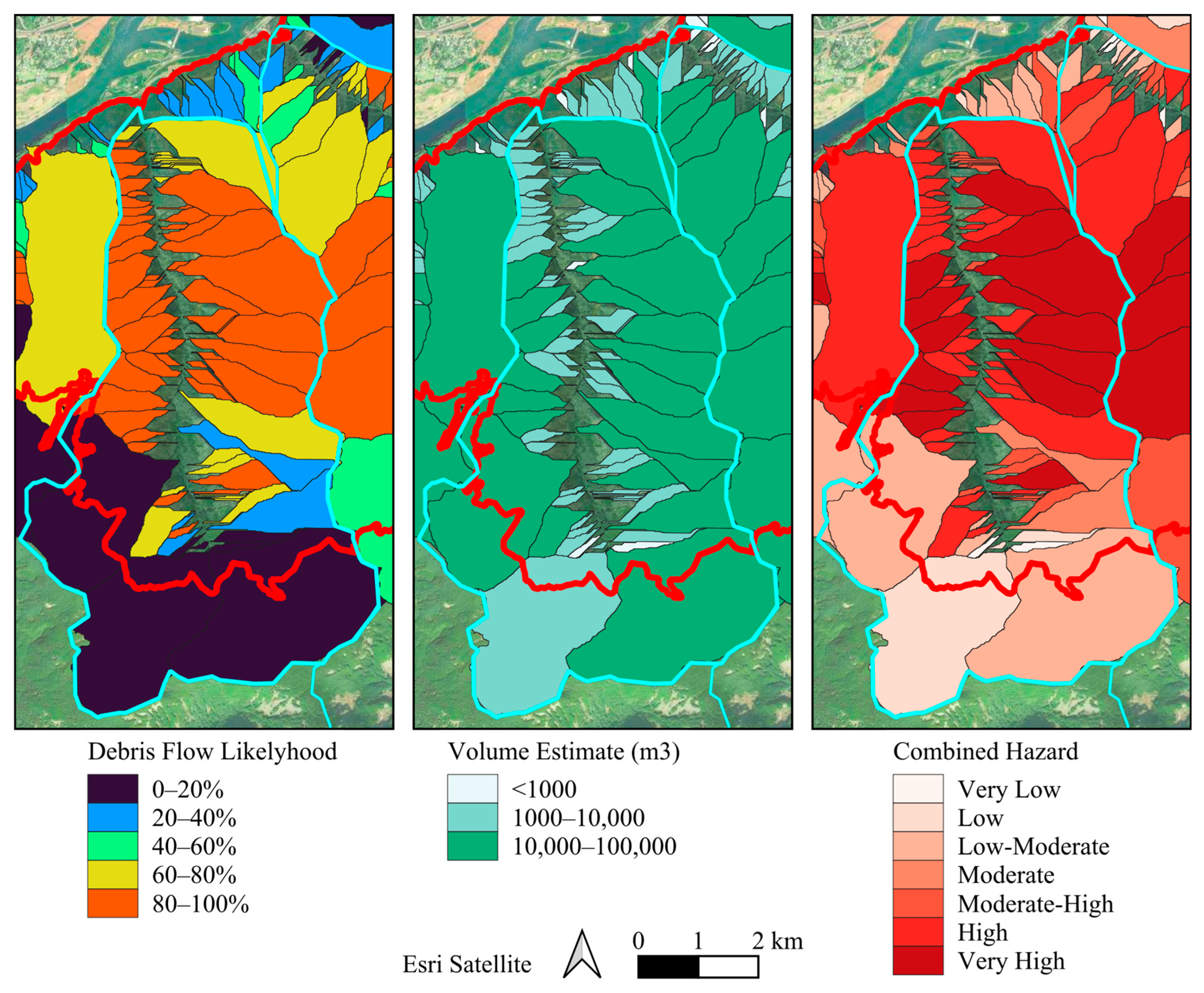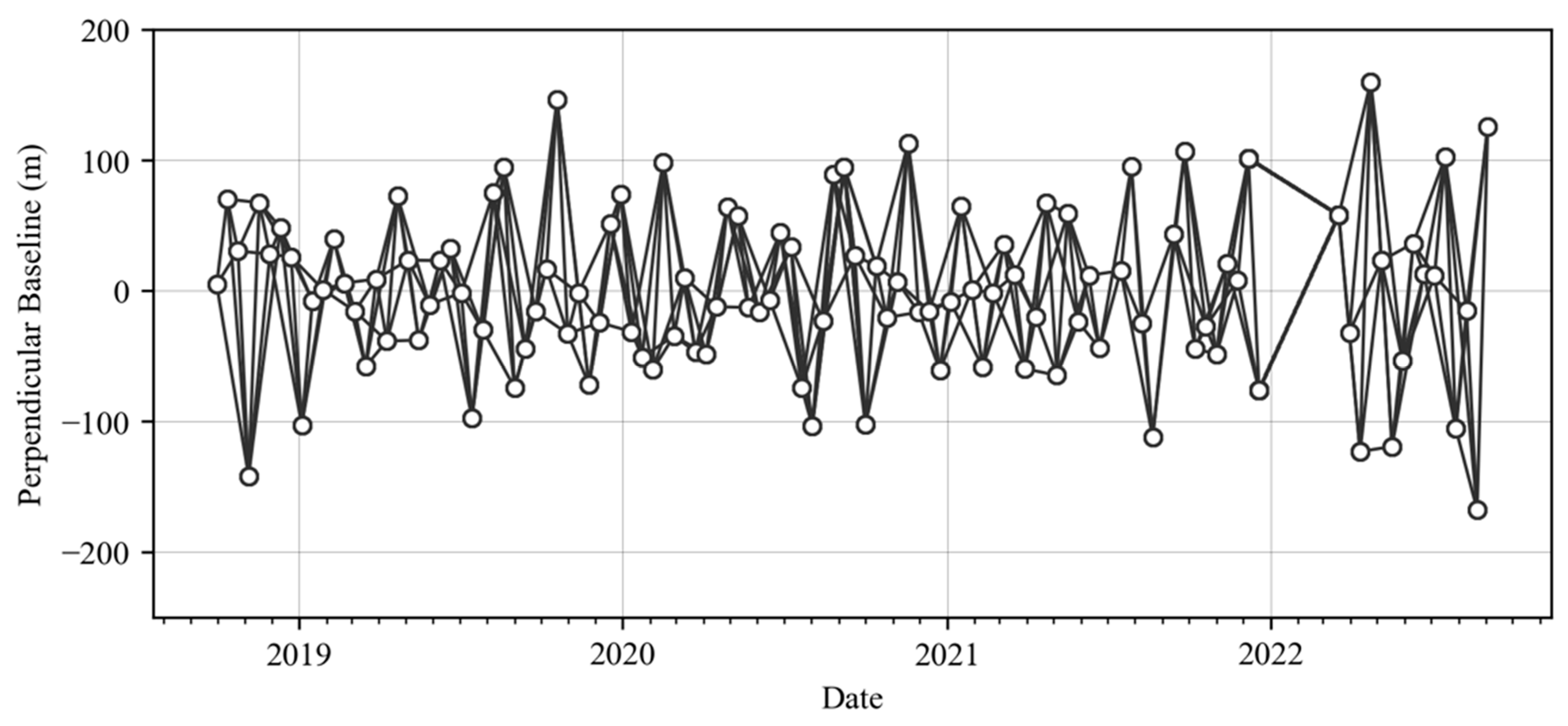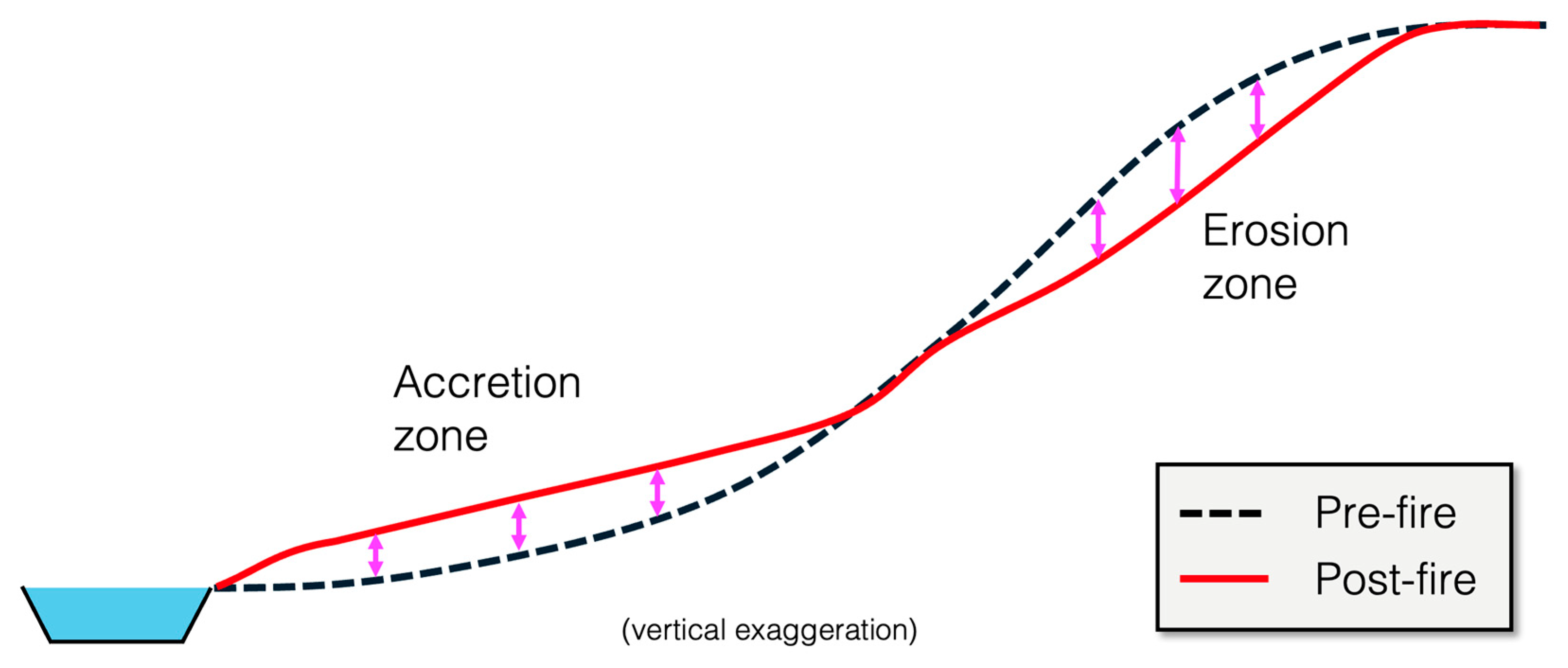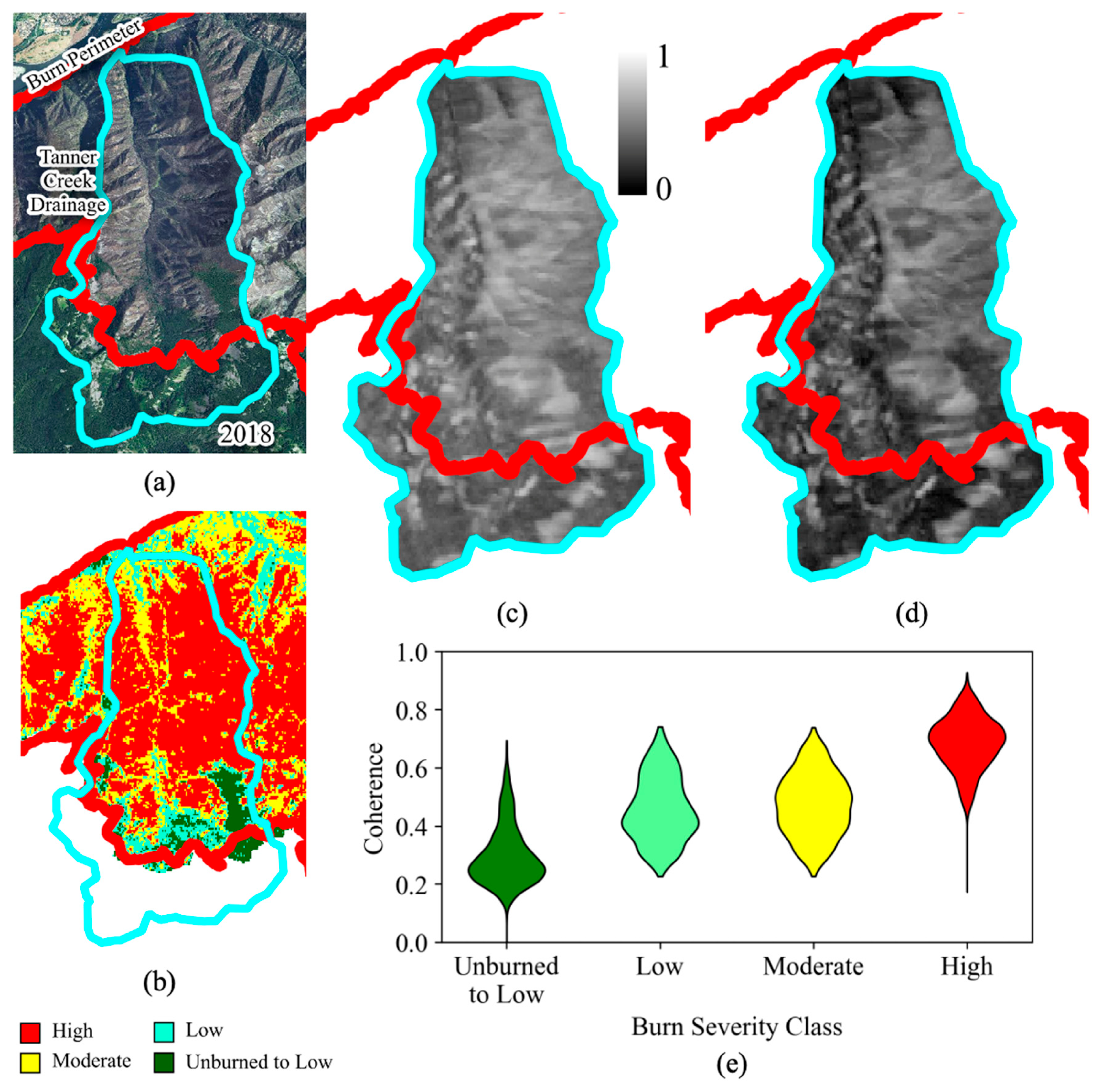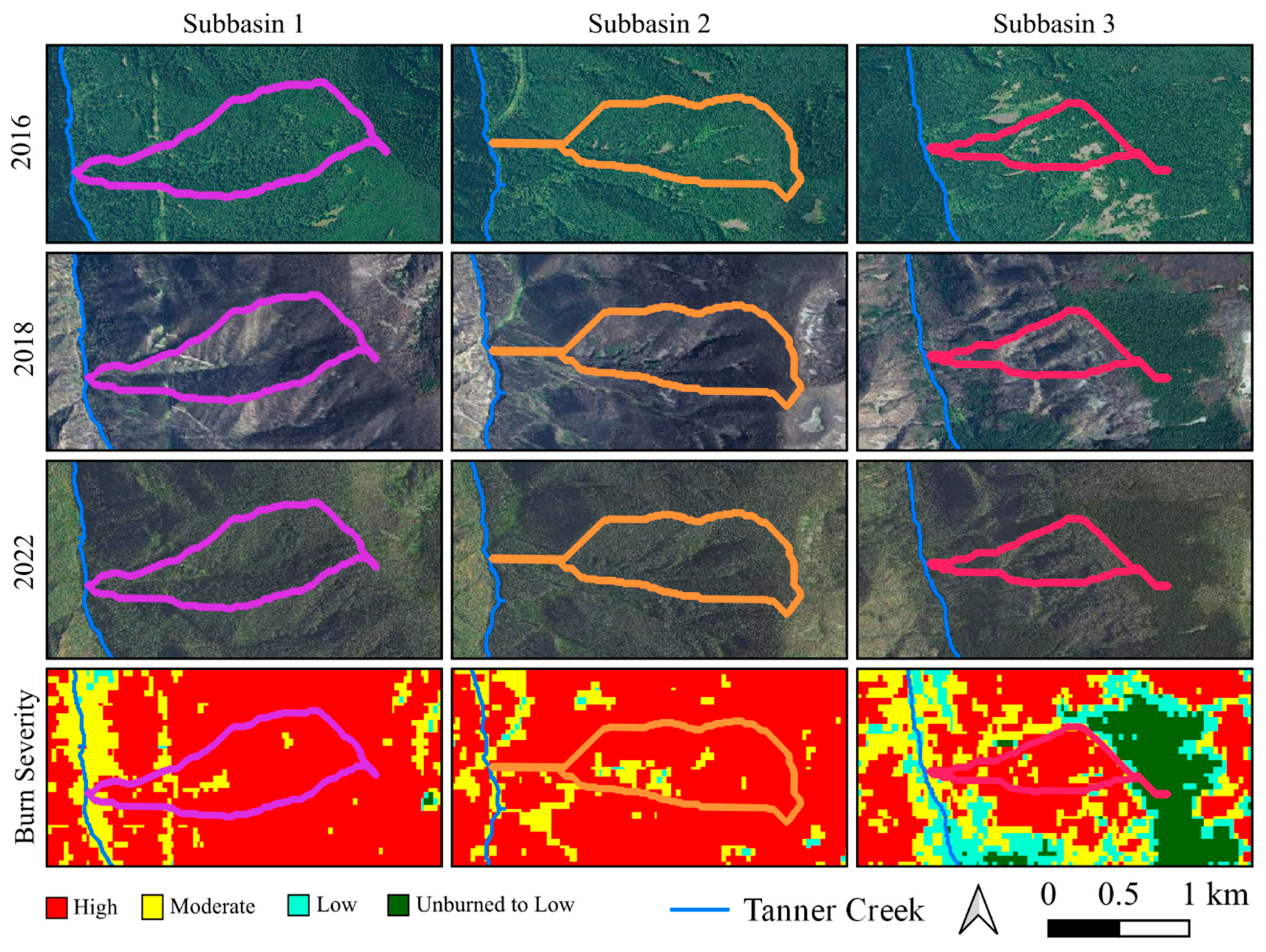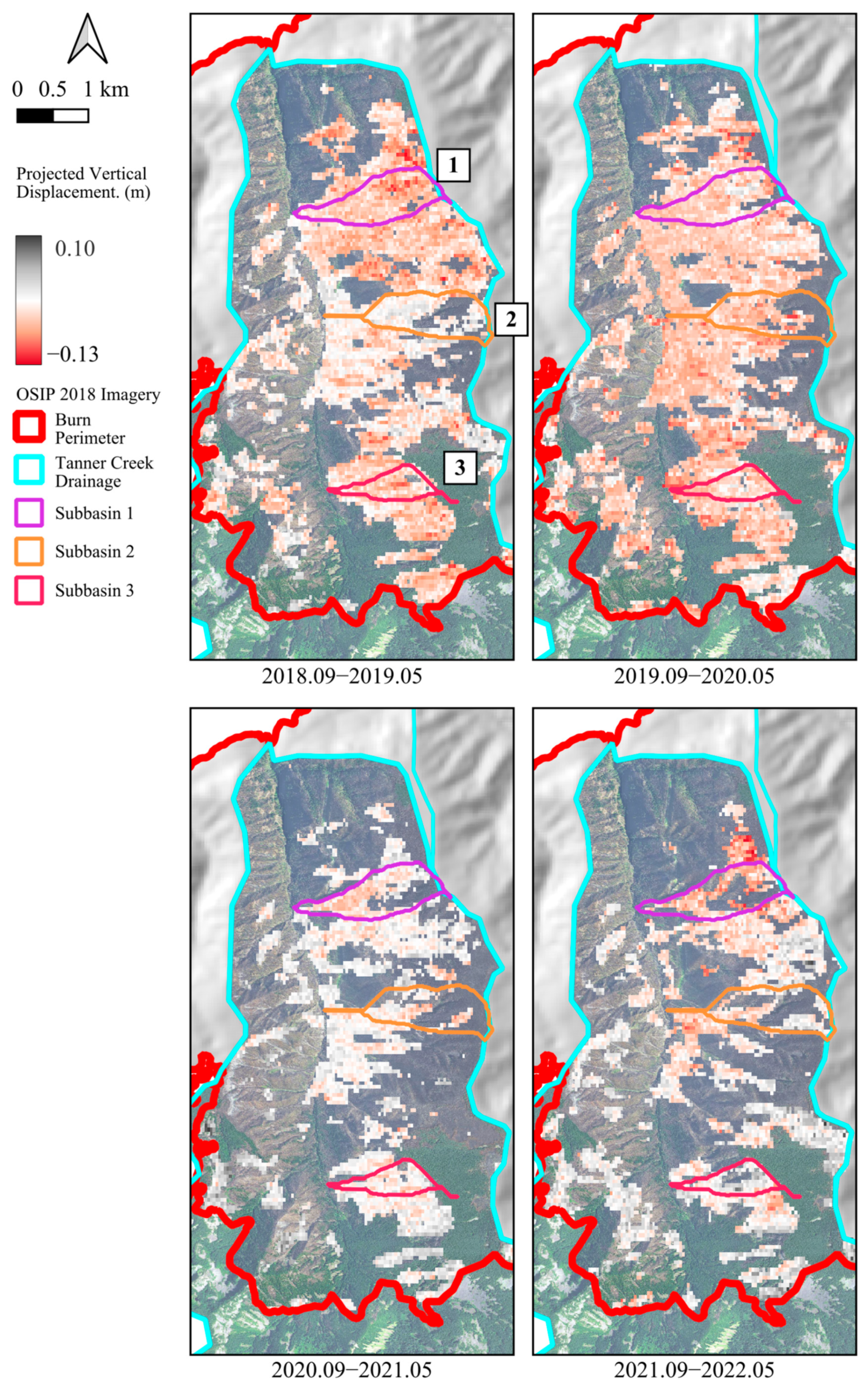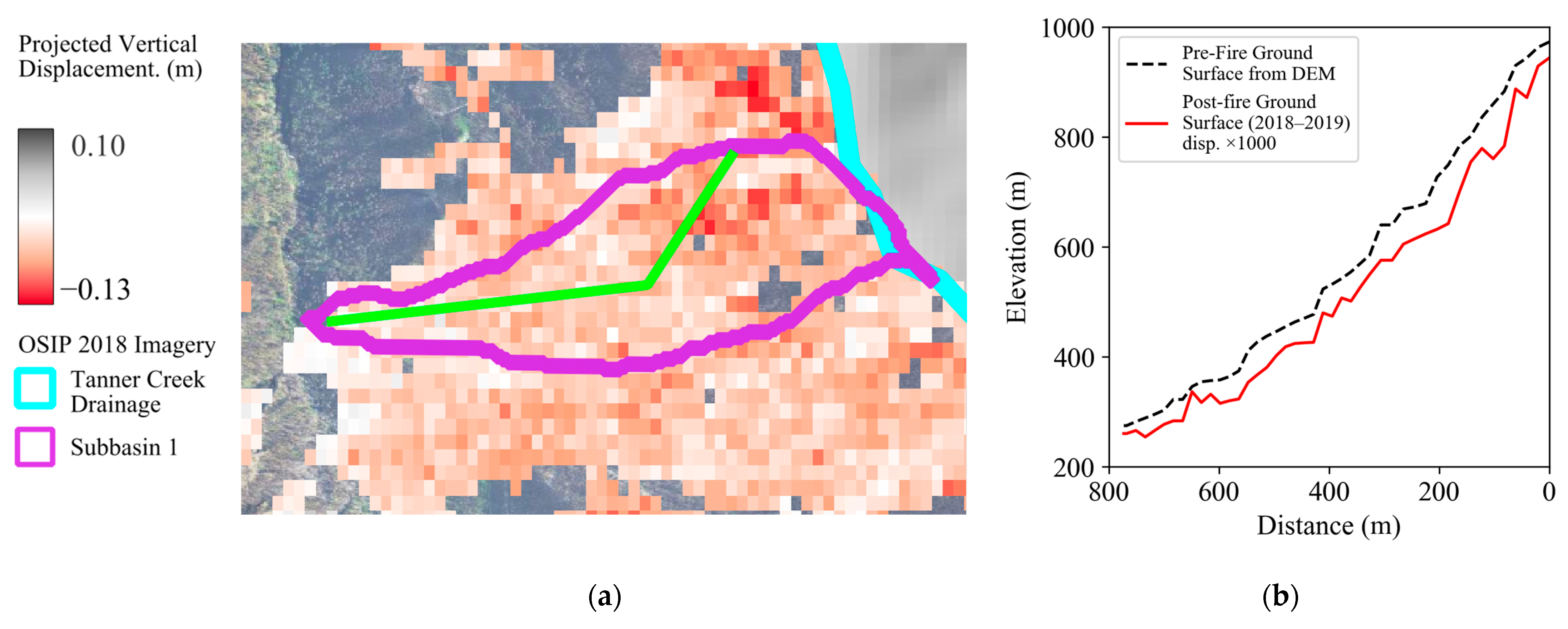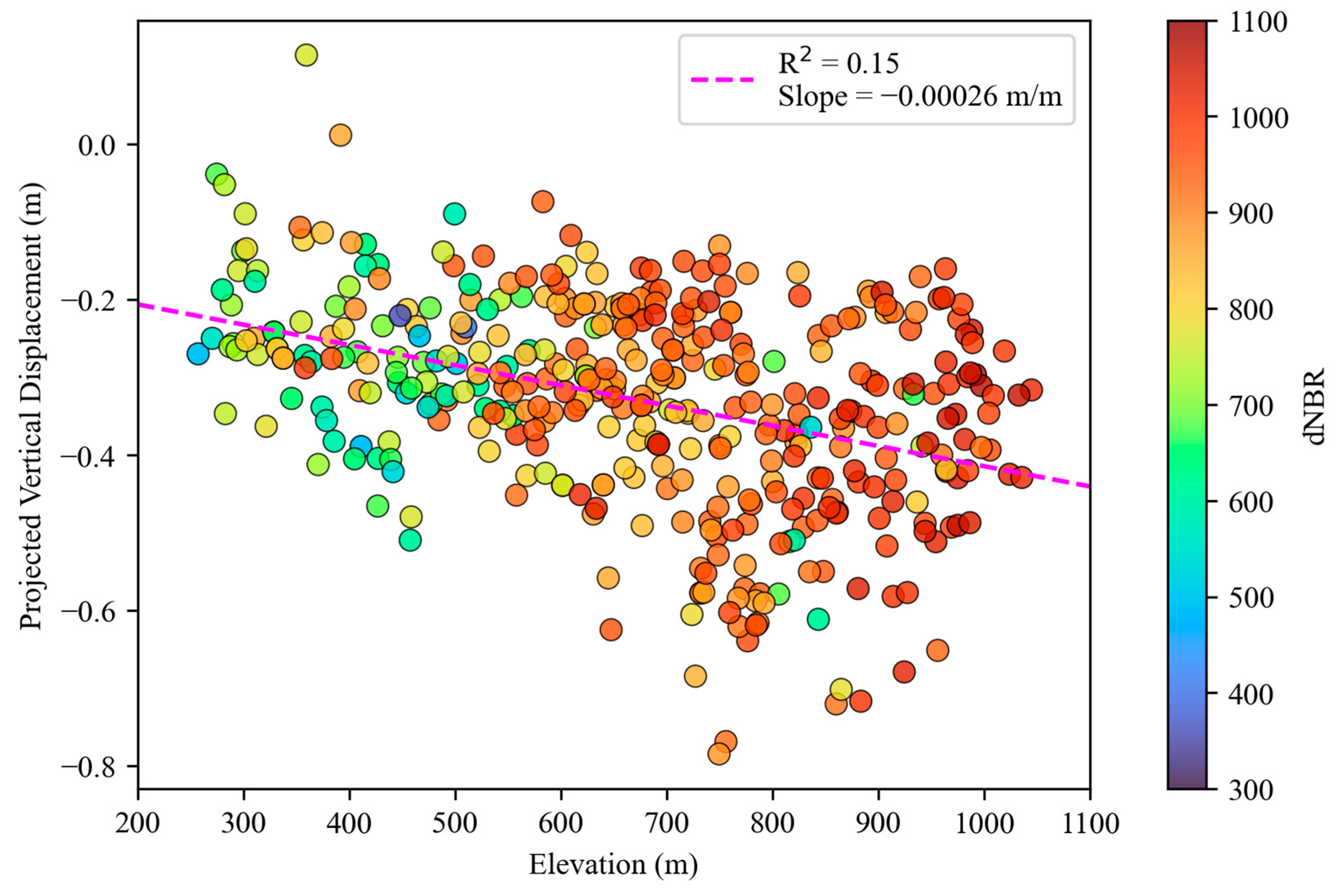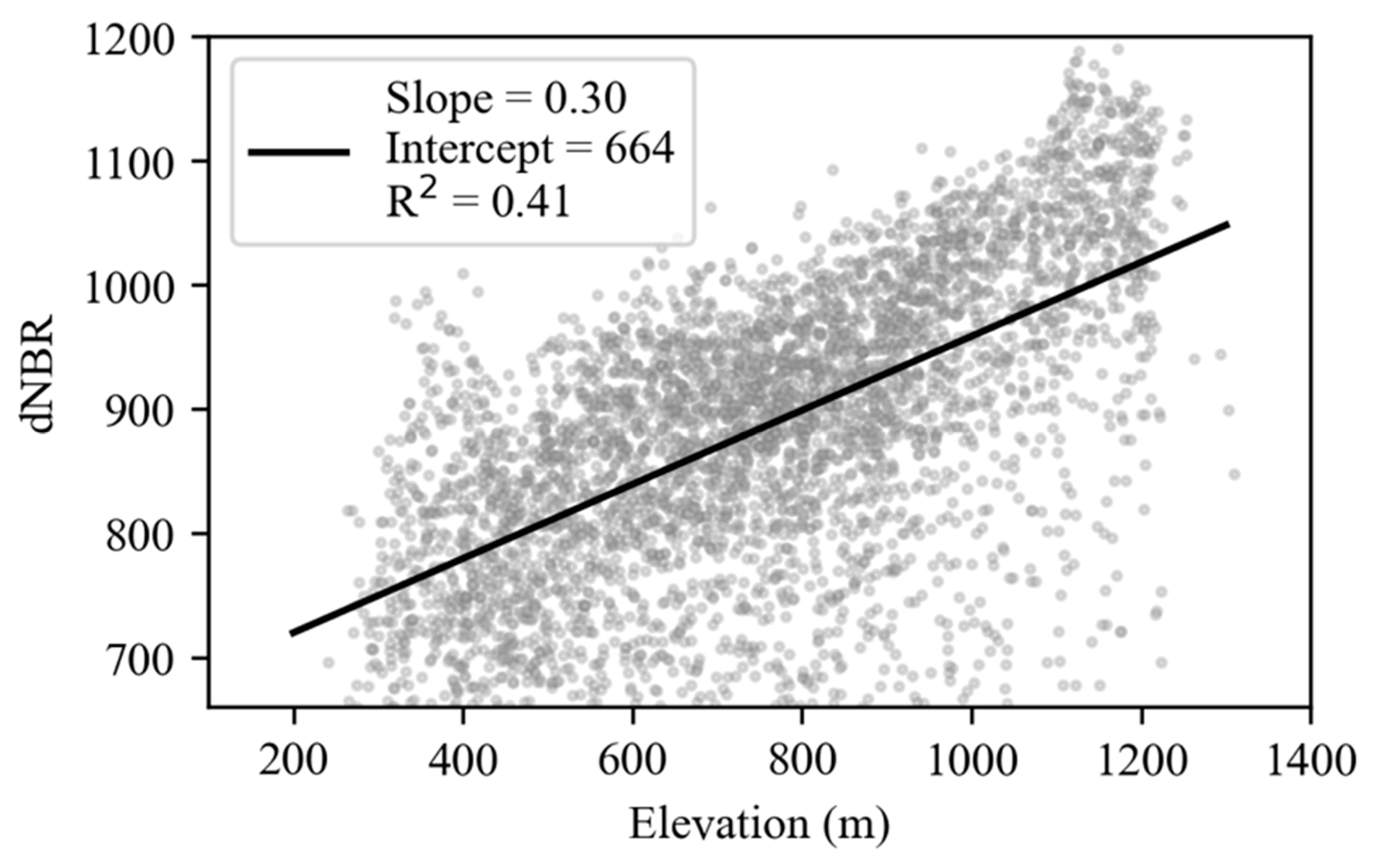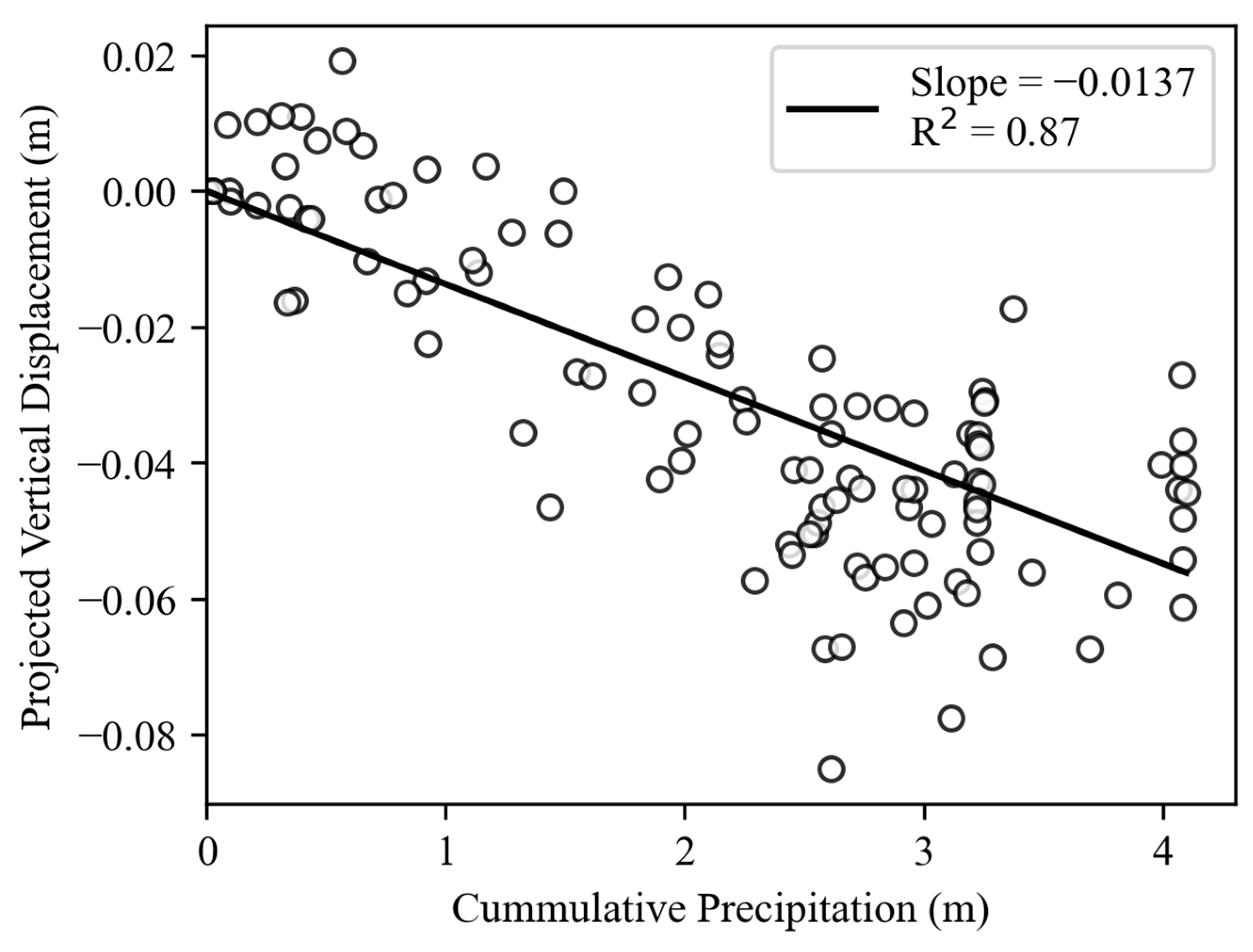1. Introduction
One of the most significant applications of remote sensing is the observation and monitoring of geohazards following extreme events. Remote sensing is experiencing increasing and emergent use in the fields of geology, geotechnical engineering, and geohazard monitoring, particularly of surficial change. Notable extreme events such as earthquakes, landslides, and wildfires may create surface deformations that alter the natural and built environment significantly and are measurable using remote sensing techniques. For example, Rathje and Franke (2016) identify three primary applications for remote sensing in post-disaster reconnaissance: assessment of damage patterns, development of digital elevation models, and measurement of ground surface movement [
1]. While the aforementioned work looks through the lens of earthquake reconnaissance, the general themes are widely applicable to other geohazards that necessitate monitoring changes over large spatial and temporal extents. Others have explored the use of airborne and terrestrial LiDAR (light detection and ranging) for monitoring elevation changes before, during, and after an extreme event (i.e., [
2,
3]). UAVs (uninhabited aerial vehicles), carrying photographic equipment, LiDAR systems, or radar sensors, have also been employed (Jet Propulsion Laboratory’s UAVSAR [
2]). Satellite photogrammetry and change detection processing of aerial imagery have been used to detect landslides following the Fish fire in Southern California [
3,
4].
One technology that is experiencing increasing use in hazard monitoring is Synthetic Aperture Radar (SAR). SAR is an active sensor, providing its own energy source that allows for measurement at any time of day with no reliance on a passive energy source (such as optical imagery’s reliance on reflected solar radiation). In general, SAR has “all-weather” measurement capabilities: the microwave wavelengths experience little attenuation in most weather conditions except for heavy rainfall. The Sentinel-1 A satellite used in this study has a 12-day (same track) repeat interval, which allows for time series generation with a 12-day epoch. With multiple SAR data, techniques such as Differential Interferometric SAR (DInSAR) can be used to estimate ground surface change using the difference in phase between a pair of interferograms. DInSAR has seen increasing application in areas of disaster and extreme event monitoring because of its relatively refined spatial and temporal resolution as well as extended global coverage. Several advanced DInSAR processing algorithms have been developed. One such technique is Permanent Scatterer SAR interferometry (PSInSAR), which targets pixels with stable coherence, which are often human-made objects in urban or developed regions [
5]. Time series generation with this technique has been shown to be more effective at identifying coherent pixels in densely vegetated and forested areas [
5,
6,
7]; however, this method currently requires proprietary processing tools that necessitate more demanding computational resources. In addition, PS techniques are generally less applicable to vegetated areas due to their reliance on the presence of permanent objects. Techniques have been developed, such as SqueeSAR, that combine PS and DS (distributed scatterer) processing and have been shown to perform well in vegetated areas [
8]. Other techniques, such as SAR amplitude pixel-offset, use information from the amplitude of the received signal instead of the phase for estimating deformation [
9].
The small baseline subset technique (SBAS), developed by Berardino et al. [
10], was used for this study. SBAS is a technique to perform DInSAR that exploits the relatively small spatial baseline (i.e., distance between the acquisition position of the satellite from one pass to another) and temporal separations between consecutive SAR images of the same surface area from the same track. The small spatial and temporal baselines result in a reduction in spatial and temporal noise that are often problematic when using large baseline image pairs [
10]. As a result of this technique, the predominant source of phase decorrelation is attributed to deformation at the ground surface after correcting for atmospheric delay. The general workflow starts by performing an initial phase-unwrapping of a stack of interferograms. This is followed by an estimate of the temporal low-pass component of the deformation and any possible topographic effects before inverting the interferograms using a singular value decomposition-based approach [
10]. Details on the specific processing workflow used in this study are described in the Methods section.
DInSAR has been applied primarily to geophysical phenomena where associated ground changes are slow, occur over a long period of time, or already show early warning signs for hazards, like slow-moving landslides and rock slopes [
11,
12,
13,
14], coastal hazards associated with relative sea level rise [
15,
16], ground surface displacements due to resource extraction and wastewater injection [
17,
18,
19], and in the development of early warning systems [
20]. These previous works on slow-moving landslides, coastal hazards, and resource extraction have demonstrated the feasibility of using DInSAR for detecting ground surfaces changes resulting from different causes and in many geologic settings. These studies have demonstrated the ability of DInSAR to create accurate time series measurements of ground surface deformation, often where GPS sensors, ground-based (i.e., total station) surveying, or aerial-based (i.e., LiDAR) surveying is available to validate the results [
1,
2,
3,
4,
5,
6,
7,
8,
9,
10,
11,
12,
13,
14,
15,
16]. The successful demonstration of DInSAR performance allows for the extension of the technique to non-monitored locations and areas where GPS or surveying is not available.
Due to the extreme nature of wildfires, the potentially remote and vast areas impacted, and the hazards encountered in accessing burned sites, remote sensing tools have particular utility for monitoring and assessing the impact of wildfires when widespread in situ instrumentation is not feasible. Remote sensing has been used to evaluate many stages of fire disturbance, including the use of SAR backscatter analysis to evaluate the spatial composition and structure of vegetation following fire disturbances [
21].
One aspect of recent interest is the effect of wildfires on erosion and slope instability, which is contingent primarily on the hydrologic and mechanical properties of parent hillslope materials [
4,
22]. Rainfall is an important factor for triggering slope instabilities, such as erosion. The effects of rainfall on slope instability can be exacerbated by changes in the near-surface hydrologic cycle following a wildfire. Soil properties and forested hillslope processes such as evapotranspiration, rainfall interception, infiltration, and runoff exist in a critical balance on marginally stable slopes [
23]. The impacts of severe wildfire potentially act to disrupt this balance in both the short- and long-term conditions. In the short-term, burning of vegetation (trees and groundcover) reduces water interception and evapotranspiration, and the burned material may create a hydrophobic layer on the ground surface. These factors combine to result in increased runoff quantities and velocities; the primary concerns in the first several years are debris flows and flash flooding. In the longer term (over several years), hydrophobic materials eventually become eroded, potentially leading to degraded water quality. In addition, the degradation of the root systems, which act to anchor the slope, can lead to instability, especially on steep slopes. Degraded roots may also open preferential flow channels within a slope, leading to localized failure conditions that yield a long-term concern: shallow landslides [
24].
The focus of this study is to investigate the feasibility of using small-baseline subset differential interferometric synthetic aperture radar (SBAS-DInSAR) to interpret changes in ground surface elevation following large wildfires, with a specific application to the Tanner Creek drainage basin in northwestern Oregon, which experienced severe burning from the Eagle Creek Fire in 2017. We assess the temporal changes in the distribution or the estimated displacement, the spatial interferometric coherence, and explore connections to precipitation, soil moisture, and burn severity.
2. Wildfire Site and Geological Setting
The Eagle Creek Fire occurred in 2017, predominantly in the US state of Oregon, burning an estimated 200 km
2 between its initiation in early September and its declared containment in late November [
25]. The wildfire perimeter delineated in
Figure 1 is in a mountainous and landslide-prone region in the Mark O. Hatfield Wilderness, adjacent to both the Columbia River and the Historic Columbia River Highway to the north and the Mount Hood National Forest to the South. It is a popular outdoor destination, with extensive hiking trails and several scenic waterfalls. The area that burned experiences a wide range of precipitation in the form of snow and rainfall, much of which occurs between October and May. The area has numerous drainages with frequent debris flow activity, usually following rain-on-snow events. The steep, incised inner gorges of the Columbia River Basalt are subject to rapid weathering and frequent erosion, resulting in numerous landslides and sediment recruitment into channels below, resulting in perennial debris flow hazards. Bedrock geology at the site is predominantly basalt belonging to the Grande Ronde and Northwest Cascade Volcanoes formations [
26]. Surficial conditions consist of exposed weathered rock, soils, and steep talus slopes. Vegetation is predominantly thick Douglas Fir forests. Elevations in the Tanner Creek drainage basin, which encompasses approximately 37.1 square kilometers, range from approximately 30 m to 1330 m.
The burn resulted in the 80-day closure of more than 120 miles of National Forest System hiking trails and 10 km of the Historic Columbia River Highway to allow for the removal of unstable trees along the highway [
25]. Following the fire, a multi-agency group known as Monitoring Trends in Burn Severity (MTBS) and the Burned Area Emergency Response team (BAER) [
27] evaluated the extent and severity of soil burning at the site of the Eagle Creek fire. Along with on-the-ground inspection, the group leverages satellite imagery from Landsat satellites and imagery from Sentinel-2 from before and after the fire, to determine the extent and severity of the fire on the landscape, particularly as it relates to changes in vegetation. Satellite observations were compared with limited field survey of ground conditions. Aerial imagery obtained from the Oregon Statewide Imagery Program (OSIP) before (2016) and after the fire (2018) demonstrates the effect on tree cover, both in the steep slopes adjacent to the Columbia River and in the mountainous central region of the burn perimeter.
Figure 2 shows the ortho imagery taken before and after the fire alongside the burn severity map to demonstrate the effect of the fire on the vegetation coverage.
The MTBS and BAER survey determined that the central region, comprising the Eagle Creek and Tanner Creek drainage basins, was the most severely burned area with an estimated ground vegetation recovery time in these two drainage basins of 5–10 years [
27].
Figure 3 shows a photograph of a burned slope in the Tanner Creek drainage basin taken after the fire, demonstrating the steepness of the terrain and extent of burning [
28]. Generally, soils subjected to higher burn severity have reduced infiltration, thus increasing the likelihood of surface erosion, debris flows, and landslides [
25]. However, in the cool and wet climate of Oregon, it is less clear as to the long-term effects severe wildfire pose as it relates to the timescales of change stemming from landslides, erosion and debris flows at large scales—DInSAR may serve as a means for quantifying these changes at short- and medium-timescales.
Burn severity and soil burn severity are important components of the US Geological Survey’s current models for estimating the likelihood and volume of debris flow in post-wildfire landscapes [
29]. The preliminary hazard assessment comprises both a debris flow likelihood model based on logistic regression and a volume estimate model that uses multiple linear regression; outputs from these two models are ranked and summed to produce a combined hazard rating for each subbasin within the burn perimeter. The likelihood model is based on the proportion of upslope area burned to a certain severity, the average differenced normalized burn ratio (dNBR) in the upslope area, and soil erodibility. The volume estimate model is based on the range of elevations within the basin and the upstream burned area [
29]. Parameters in the two models are based on empirical case histories of wildfires in the Western United States. Likelihood and volume estimates are made for several precipitation events defined by a peak 15 min intensity ranging from 12 to 40 mm/h [
30]. Volume is estimated at the drainage basin-scale using the elevation range within the basin, the upstream area burned (moderate severity or higher), and the design peak 15 min rainfall intensity. Volume estimates are shown in
Figure 4 and categorized into three categories: “low”, 0–1000, “medium” 1000–10,000, “high” 10,000–100,000, and “very high” > 100,000 m
3. These USGS models are specific to recently burned areas in the Western United States.
While useful, this model is a one-time estimation based on previous case histories and does not necessarily consider the local-scale hydrological and ecological intricacies of a particular burn region, regrowth of vegetation, or the potential impacts of evolving hydrologic conditions in the years following a fire. By using spaceborne optical or radar image products, such as DInSAR, a method for continual monitoring of burned areas could contribute to hazard mitigation by providing regularly updated measurements of site-specific ground surface changes.
3. Methods
Data from the European Space Agency’s Sentinel-1 A satellite was used in this study. Sentinel-1 A is equipped with a C-band microwave sensor that has a wavelength of approximately 5.55 cm. [
31]. C-band is well-suited for measuring changes in ground elevation in areas with low to moderate vegetation cover that, in general, have high coherence compared to densely forested area [
32]. C-band radiation only partially penetrates forest canopies, resulting in volume scattering and decorrelation of the phase signal in heavily forested areas. In fact, heavy vegetation and tree cover is one of the main limitations of C-band SAR. The circumstances of this study, however, make C-band SAR applicable where it typically would not be, since the wildfire removed vegetation from many areas within the Tanner Creek drainage basin. Following the fire, the burned areas consisted of primarily of exposed soil and rock with limited surface vegetation, allowing for high coherence in these areas.
SAR imagery was obtained using Vertex, the Alaska Satellite Facility (ASF) data search application, to order on-demand Level-2 SAR imagery from the Sentinel-1 A satellite, ascending path 137, and processing with multi-look factor of 10 × 2 (range and azimuth directions) for a pixel size of approximately 38 m × 55 m in the range and azimuth directions, respectively. The ASF hosts NASA’s archive of SAR data and operates a suite of open-source processing tools in a cloud-computing environment, including OpenSARLab [
33]. Interferogram pairs were generated using a temporal baseline (time between acquisitions) of 12 to 36 days, except in one case where pairs were manually created with longer temporal baselines due to unavailable interferograms: 19 December 2021–19 March 2022 (temporal baseline of 90 days). The temporal and perpendicular baselines of all acquisition pairs are shown in
Figure 5. Interferograms were obtained from NASA’s SAR DAAC for a four-year period spanning approximate water years 2019 to 2022.
The data were brought into the OpenSARLab computing environment and processed following the SBAS technique using Miami InSAR Time-series Software in Python (MintPy, v1.60) [
34]. Data pre-processing included creation and co-registration of image stacks resampled to the limits of the area of interest. The SBAS analysis, performed using MintPy, includes digital elevation model terrain corrections and tropospheric delay corrections and enables development of a displacement time series with high spatial density and extent using multiple chronologically acquired interferometric pairs.
MintPy starts with a stack of phase-unwrapped interferograms that have undergone correction for Earth curvature and topographic effects. All interferograms are then temporally referenced to the first image. The software then selects a spatial reference point by identifying and selecting a pixel with high average spatial coherence. After identifying temporal and spatial references, unwrapping error correction is applied utilizing the bridging of reliable regions as described in [
35]. This method is particularly suited to regions with steep topography, such as the Tanner Creek drainage in this study. The interferogram network is then inverted before applying phase spatial coherence masking. The phase timeseries then undergoes correction for tropospheric delay using ERA-5 dataset and topographic errors using a digital elevation model (3-arc second SRTM DEM). Residual phase noise is then evaluated and removed before estimating line-of-site displacement and velocity. Refer to [
34] for details on each processing step.
The time step of the timeseries depends on the repeat pass interval of the satellite being used and is 12 days for the Sentinel-1 A satellite used in this study. MintPy only supports single-track processing, thus only images from Sentinel-1 A along the same track were used. Line-of-sight (LOS) displacement was projected to vertical displacement using the following formula:
where
is vertical displacement,
is displacement in the LOS of the satellite, and
is the incident angle between the satellite look vector and a line normal to the ellipsoid. This projection assumes that all displacement observed by the satellite in the LOS direction is derived from vertical displacement of the ground surface and does not include a horizontal component. Consideration of the horizontal component is important in cases where slopes are moderate and the horizontal component may be significant, or where the ground surface displacements are a result of the movement of a large mass of soil (i.e., slow-moving landslides), or in cases where the phenomenon being measured occurs over a long timescale. In the Tanner Brook Drainage, the predominant driver of changes in the ground surface elevation is erosion following intense precipitation events, which occurs in intermittent and spatially distributed events. Additionally, these erosive events typically occur on a much shorter time scale than the repeat-pass interval of the satellite. Thus, the use of vertical projection is well suited to estimate changes in the ground surface resulting from these short-lived events. A schematic depicting this is shown in
Figure 6.
Generally, coherence threshold of 0.2 to 0.3 is used in vegetated areas (see [
2] where a coherence threshold of 0.3 was used to mask pixels in vegetated areas adjacent to the study are). The intent of a coherence threshold is to exclude pixels where decorrelation is significant and likely not a result of ground surface deformation, rather attributed to the effects of vegetation. In the Tanner Creek Drainage, many areas outside of the exposed slopes are densely forested and have low coherence. Low coherence in these areas increases uncertainty in the measured deformation. Since the objective of the study is to observe ground surface changes resulting from erosion in the exposed slopes, a coherence threshold of 0.5 was selected for this study which effectively masked adjacent vegetated areas and retained pixels within the exposed slopes burned to a high severity.
5. Discussion
Advances in the application of new data, technologies, and tools are accelerated when barriers to access are reduced or removed. DInSAR offers many favorable characteristics for hazard monitoring, and the ability to freely access SAR data and process it using state-of-the-art algorithms and techniques in a cloud-based computing environment offers tremendous opportunity to expand its uses in hazard monitoring and potentially landscape recovery following wildfire.
The ability of SAR with the Sentinel-1 A satellite to make consistent measurements at an approximate 12-day repeat pass interval over a very large area is one of the greatest draws of this technology for hazard monitoring. This is especially relevant in the context of post-wildfire monitoring, where the affected area is often large and generally difficult to access. Deployment of traditional in situ instrumentation, such as GPS stations or inclinometers, or surveying of the area using traditional ground-based survey, LiDAR, and/or photogrammetry can be cost-prohibitive and infeasible. It would be unreasonable to, for example, fly LiDAR every 12 days for many years over a site of several square kilometers. One limitation of DInSAR in this regard is that the spatial resolution may not be fine enough to capture refined details in some smaller sites. Additionally, in some cases the 12-day repeat pass interval may not be a fine enough temporal resolution to capture short-term critical events. While longer-term phenomena, such as erosion, accretion, and vegetation regrowth can be captured with this temporal measurement interval, the progression of short-term phenomena such as a sudden movement of material (i.e., debris flows, landslides) may not be captured, except before and after.
Rainfall is the principal driver of slope instabilities such as erosion or shallow landslides; significant wildfires change the near-surface hydrologic cycle and create conditions that can exacerbate the effects of rainfall and increase the quantity and intensity of runoff. Thus, establishing a connection between rainfall quantity and ground surface changes is important. We found that the three subbasins in the Tanner Creek drainage investigated in this study showed a strong connection between accumulated precipitation throughout the water year, rootzone soil moisture, and ground surface deformation. We found that there appears to be a lag between the initiation of precipitation at the start of the water year and the initiation of ground surface deformations. This is observed for all four water years covered in this study (2019–2022) when compared to the long-term time series of projected vertical displacement at the three subbasins (see
Figure 14). We also found an increased rate in the ground surface deformation during periods of elevated rootzone soil moisture (see
Figure 15) and a strong relationship between cumulative precipitation and ground surface deformation (see
Figure 16).
The use of SAR for post-wildfire hazard monitoring is not without its limitations. Firstly, as mentioned above, the area being monitored may be devoid of existing instrumentation (i.e., GPS stations) that could be used to verify the DInSAR measurements. Of course, it is an asset of remote sensing, in general, that measurements can be made at un-monitored locations, and studies using DInSAR in monitored locations have shown good reliability of the technique as discussed earlier. If limited in situ monitoring is an option, DInSAR could first be used to assess potential locations for deployment of sensors to help ensure they are optimally located in critical areas.
The interferometric coherence also shows strong potential for use in both masking unburned areas and in monitoring vegetation regrowth over time. Vegetation regrowth will limit the measurable area over time due to decreases in interferometric coherence. This effect is observed in
Figure 9 where the area covered by coherent pixels decreases with time from the wildfire or disturbance. Thus, use of DInSAR for post-wildfire hazard monitoring is potentially limited by the rate of vegetation regrowth. In many cases, the vegetation regrowth period, and areas that experience high burn severity, may maintain relatively high coherence (e.g.,
Figure 7c,d) for several years to a decade; so, DInSAR may still be useful for some years. As demonstrated in
Figure 7e, interferometric coherence is related sensitive to the burn severity and the presence of vegetation; therefore, it could be a valuable asset for monitoring of regrowth of vegetation following a wildfire and could be used as a complement to the dNBR.
